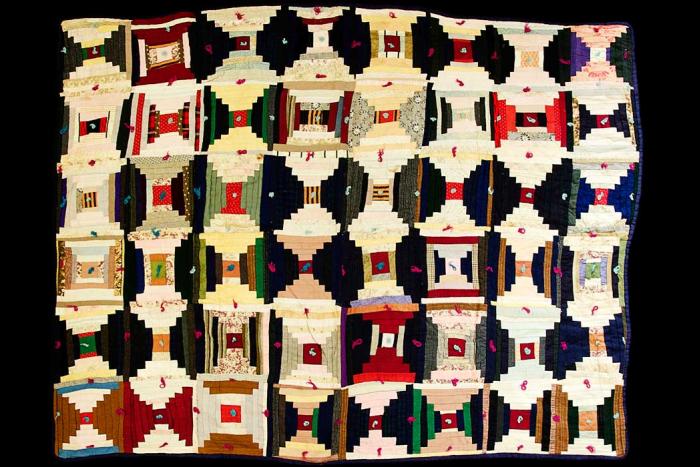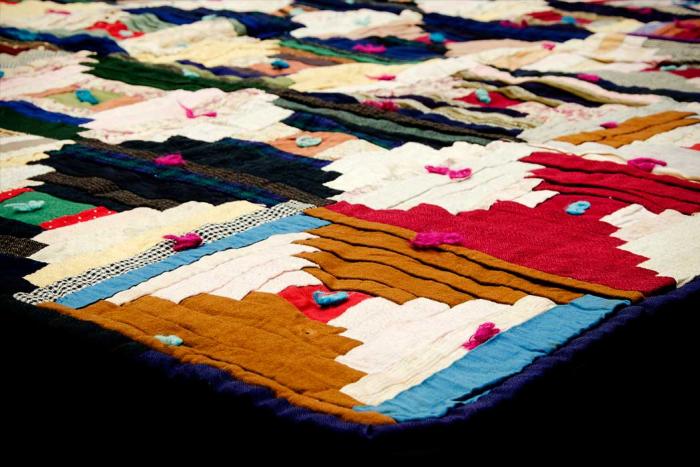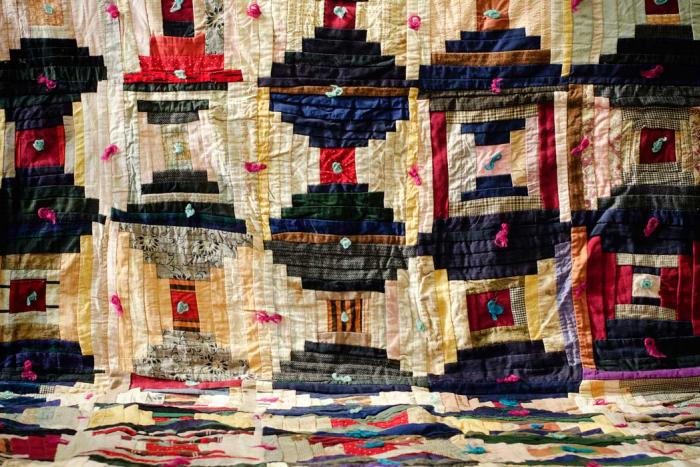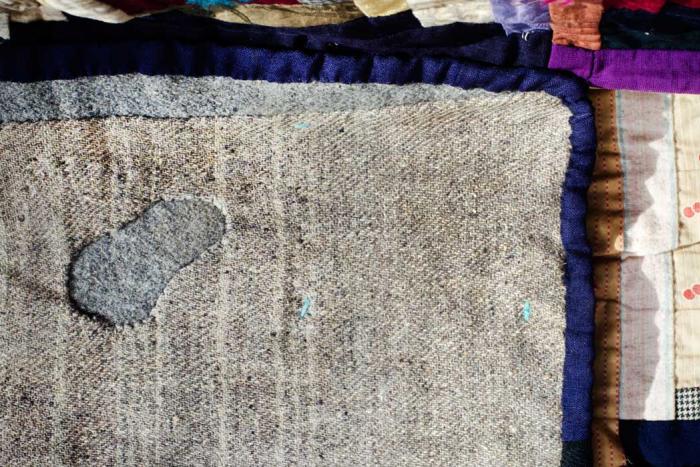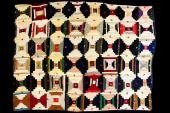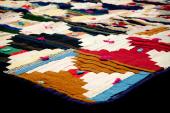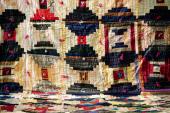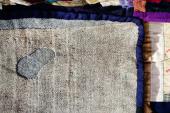Quilt, Hurdman Family
Organization: Aylmer Heritage Association
Address: 495 Aylmer Rd., Gatineau, or P. O. Box 476, Gatineau, QC J9H 5E7
Region: Outaouais
Contact: Michael MacDonald, heritage.aylmer(a)videotron.ca
Description: Handmade and tufted quilt made by Martha Jowsey Hurdman in the “Courthouse Steps” pattern.
Year made: 1890s
Made by: Martha Jowsey Hurdman (1840-1924)
Materials/Medium: Woollen blanket material, wool serge
Colours: Grey, blue, multi-coloured
Provenance: Breckenridge, Township of Eardley, Quebec
Size: 2.1 m x 1.52 m
Photos: David Irvine. Courtesy Aylmer Heritage Association
Martha Jowsey Hurdman’s Quilt, c. 1890
Anita Rutledge and Michael MacDonald
The assembly of the quilt is a bit out of the ordinary, but it is colourful and practical and was very likely treasured as a cheery work of art and comforting warm cover on beds in Martha Jowsey (1840-1924) and Henry Hurdman’s (1816-1907) home beside the Ottawa River at Breckenridge, near Aylmer, Quebec. Theirs was one of several early houses built here on three Hurdman family lots in the Township of Eardley*, settled in 1818. Henry and Martha grew up on adjoining farms, both from founding families of the area. They married in 1858 and lived at the 1845 Old Lodge Farm homestead, an enduring log landmark on the road leading into the valley.
Martha made her quilt in the 1890s. It is now part of the Ritchie-Hurdman collection in the archives of the Aylmer Heritage Association, housed in its old grey stone church a few steps off Aylmer Road on Rue du Golf.
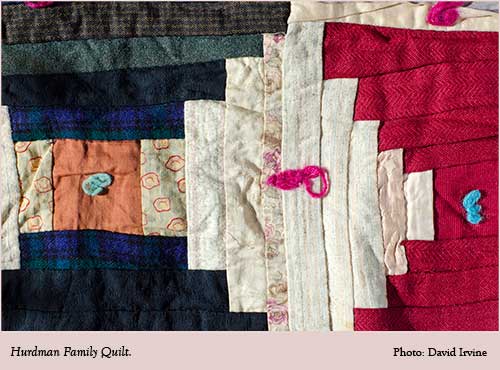
The quilt measures 2.1 metres x 1.52 metres (7'x5') and is somewhat distinctive in the materials used, as well as in the pattern of the blocks and its quilting or stitching method. As it turns out, the quilt pattern is called Courthouse Steps, a variation of the basic Log Cabin design. The multi-coloured wool tufts mean it is tied, with no actual quilting to secure the top and lining materials. Tying was sometimes used when quilts were intended for utilitarian use, or because they were too thick for needle quilting. Both of these may have been the case with Martha’s quilt because it is lined with heavy woollen blanket material, instead of lighter cotton flannelette and a batting filler, and the added warmth of the wool was probably a primary concern.
On close examination, it is obvious that Martha crafted the quilt from scraps of material on hand - pillow ticking, serge from men’s suits, shirt material, and odds and ends from dresses and other clothing, cutting and piecing together the intricate pieces of her pattern. All blocks are hand stitched together and applied directly onto a backing of two different pieces of coarsely woven grey woollen blanket material. A heavy blue border, firmly stitched around the edges, frames the quilt and makes it a firmer unit.
It is also clear that this quilt has been well used and cared for over many years; the lining even has a small neatly-stitched patch at one end. Also, it is a good example of the homemade quilts many pioneer women painstakingly put together, making do with the often scarce materials available to them.
The Log Cabin pattern Martha chose is a very popular one that over the years has spawned several variations - Barn Raising, Zig-Zag, Diamond, Sunshine and Shadows, and Windmill - in addition to her Courthouse Steps design.
Information on these patterns is gleaned from the 1977 report on Quilts of the Outaouais, a government-funded research study involving more than 75 quilters from the lower Ottawa and Gatineau valleys. The report displays pictures of 169 quilts and patterns, and lists the names of the people who made them, coming from towns or villages in both valleys. Martha’s township of Eardley was well represented. Predominantly these were English-speaking quilters, but there was good involvement by their French-speaking neighbours, bringing together the two cultures in friendship. The report was produced in both languages.
Quilters in the study came from the communities of Hull, Aylmer, Eardley, Luskville, Quyon, Bristol, Shawville, Ladysmith, Lac-des-Loups, Calumet Island, Fort Coulonge, Old Chelsea, Chelsea, Gleneagle, Kirks Ferry, Burnet, Farm Point, Wakefield, Masham, Rupert, Alcove, Lascelles, Low, Kazabazua, and Danford Lake.
One of the quilters taking part donated a poem entitled Our Quilt, written by Mrs. Rosana Gibson of the Danford Lake Ladies’Aid in 1928. It describes a quilting bee and reads in part:
And so the names were gathered from friends both far and near…
So now the quilt is finished, its beauty to behold,
And our Aid will be some richer when this lovely quilt is sold.
In the days when few women in the Outaouais region were taking jobs outside their homes, quilt-making bees were personally important, not only as a social outlet and way to express artistic style and needlework, but also perhaps the only way women had to contribute to endeavours they wanted to support. When the community-sponsored Gatineau Memorial Hospital opened its doors in Wakefield in 1952, women from all over the region had saved cotton sugar bags on which to create colourful blocks for numerous quilting bees. Eventually they donated 30 quilts - one for each of the new hospital beds. Only one of these, a quilt in the Star of Bethlehem pattern, is known to still exist, preserved at the Symmes Inn Museum in Aylmer.
This practical and charitable nature of quilt-making persisted through the hardships of settlement and two world wars. For instance, in the early 1940s the Eardley Women’s Instititute was able to donate 27 quilts as part of the Quebec Institute’s major contributions, sent overseas through the Red Cross to comfort soldiers, refugees and air-raid victims.
Today, charity quilts still remain a focus of the many groups now active in the Outaouais, but more and more there is a trend towards quilted works of art - colourful wall hangings and the like - even quilted clothing and accessories are in vogue.
Regardless of the purpose, women have always used design, in even the most needed and humble utility quilt, taking pride in creating beauty and expressing themselves artistically, while providing warmth and comfort - just as Martha Jowsey Hurdman did with her quilt in the 1890s.
*Eardley Township was founded in 1806, and was so-called until 1975 when it was amalgamated with North and South Onslow and Quyon townships to form the new Municipality of Pontiac.
Sources
Aylmer Heritage Association, heritage.aylmer [at] videotron.ca
www. heritagepontiac.ca/1583/Herdman.html
Gatineau Valley Historical Society (GVHS); MacLaren House Museum files 1980s-90s. www.gvhs.ca
Report on Quilts of the Outaouais/Courtepointes de l’Outaouais, 1977; Pat Evans Collection, GVHS - on loan to Fairbairn House Heritage Centre, Wakefield. www.fairbairn.ca
To Learn More
The Quebec Quilt Registry, www.quebecquiltregistry.org
Courtepoint Québec Quilts, www.cqq.ca
Author
Anita Rutledge is a director on the board of the Fairbairn House Heritage Centre. Michael MacDonald is a member of the Aylmer Heritage Association Board of Directors


